Literature Review: Leadership and Organizational Performance Analysis
VerifiedAdded on 2022/12/15
|13
|3235
|186
Literature Review
AI Summary
This literature review examines the critical relationship between leadership and organizational performance. It begins by defining leadership and exploring various leadership styles, including transformational, transactional, authentic, and situational approaches. The review then delves into organizational performance, discussing its significance and the factors influencing it. A significant portion of the paper analyzes the impact of leadership on several facets of organizational performance, including employee performance, financial outcomes, innovation, and sustainability and responsibility. The analysis highlights the importance of effective leadership in fostering a positive work environment, enhancing employee productivity, and driving financial success. Furthermore, it emphasizes the role of leaders in promoting innovation and ensuring long-term sustainability. The review underscores the interconnectedness of leadership and organizational success, providing insights into how different leadership styles can influence various aspects of performance. The paper concludes by identifying gaps in the existing literature, suggesting areas for further research and exploration.
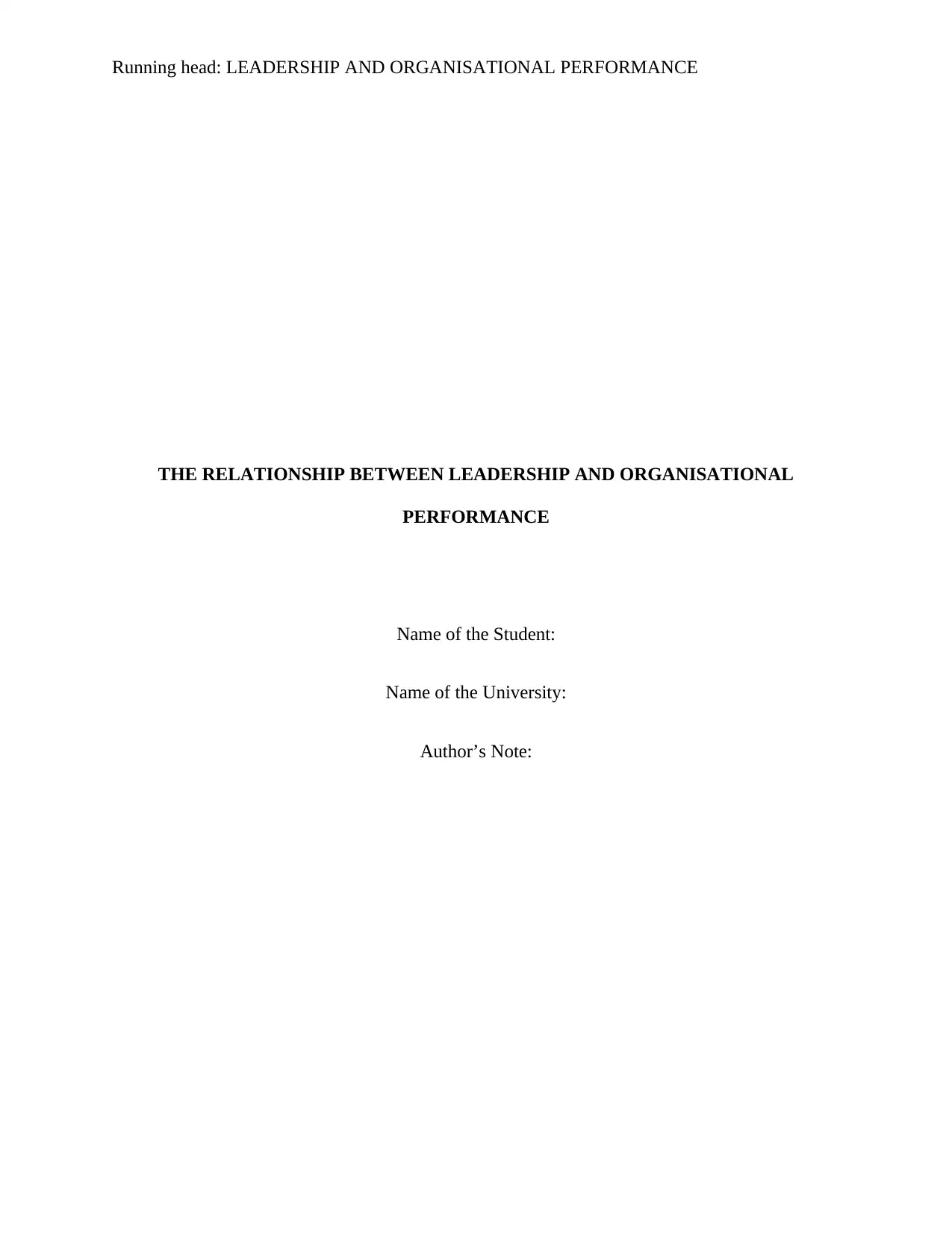
Running head: LEADERSHIP AND ORGANISATIONAL PERFORMANCE
THE RELATIONSHIP BETWEEN LEADERSHIP AND ORGANISATIONAL
PERFORMANCE
Name of the Student:
Name of the University:
Author’s Note:
THE RELATIONSHIP BETWEEN LEADERSHIP AND ORGANISATIONAL
PERFORMANCE
Name of the Student:
Name of the University:
Author’s Note:
Paraphrase This Document
Need a fresh take? Get an instant paraphrase of this document with our AI Paraphraser

1LEADERSHIP AND ORGANISATIONAL PERFORMANCE
Table of Contents
1.0 Introduction...........................................................................................................................2
2.0 Overview of the concept of Leadership.....................................................................................3
3.0 Leadership Styles.......................................................................................................................4
4.0 Overview of the concept of Organizational Performance.........................................................6
5.0 Impact of Leadership on Organizational Performance..............................................................6
5.1 Leadership and Employee Performance................................................................................6
5.2 Leadership and Financial Performance of the enterprises.....................................................7
5.3 Leadership and Innovation Performance of the enterprises..................................................7
5.4 Leadership and Sustainability and Responsibility of the enterprises....................................8
6.0 Conclusion.................................................................................................................................8
7.0 References................................................................................................................................10
Table of Contents
1.0 Introduction...........................................................................................................................2
2.0 Overview of the concept of Leadership.....................................................................................3
3.0 Leadership Styles.......................................................................................................................4
4.0 Overview of the concept of Organizational Performance.........................................................6
5.0 Impact of Leadership on Organizational Performance..............................................................6
5.1 Leadership and Employee Performance................................................................................6
5.2 Leadership and Financial Performance of the enterprises.....................................................7
5.3 Leadership and Innovation Performance of the enterprises..................................................7
5.4 Leadership and Sustainability and Responsibility of the enterprises....................................8
6.0 Conclusion.................................................................................................................................8
7.0 References................................................................................................................................10
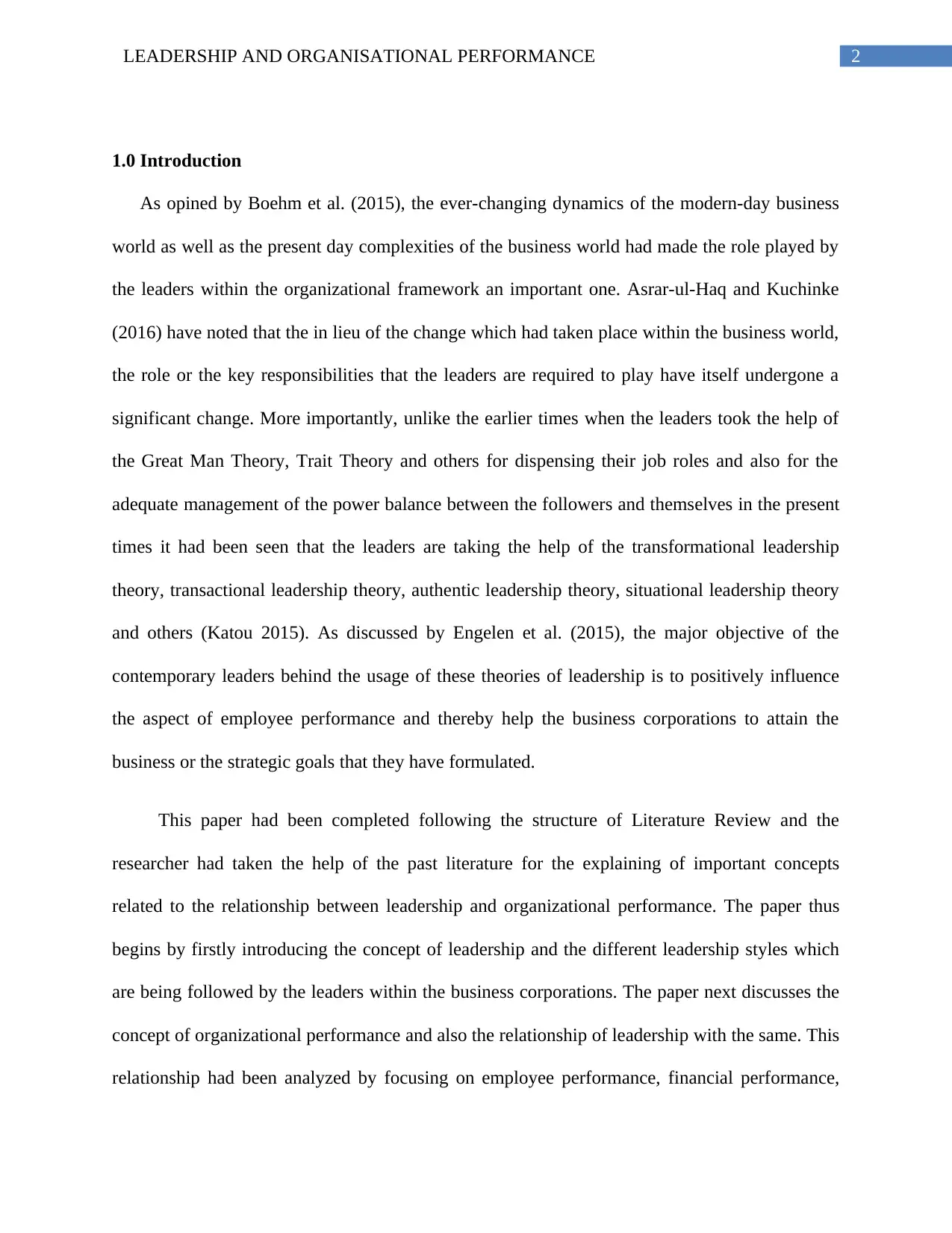
2LEADERSHIP AND ORGANISATIONAL PERFORMANCE
1.0 Introduction
As opined by Boehm et al. (2015), the ever-changing dynamics of the modern-day business
world as well as the present day complexities of the business world had made the role played by
the leaders within the organizational framework an important one. Asrar-ul-Haq and Kuchinke
(2016) have noted that the in lieu of the change which had taken place within the business world,
the role or the key responsibilities that the leaders are required to play have itself undergone a
significant change. More importantly, unlike the earlier times when the leaders took the help of
the Great Man Theory, Trait Theory and others for dispensing their job roles and also for the
adequate management of the power balance between the followers and themselves in the present
times it had been seen that the leaders are taking the help of the transformational leadership
theory, transactional leadership theory, authentic leadership theory, situational leadership theory
and others (Katou 2015). As discussed by Engelen et al. (2015), the major objective of the
contemporary leaders behind the usage of these theories of leadership is to positively influence
the aspect of employee performance and thereby help the business corporations to attain the
business or the strategic goals that they have formulated.
This paper had been completed following the structure of Literature Review and the
researcher had taken the help of the past literature for the explaining of important concepts
related to the relationship between leadership and organizational performance. The paper thus
begins by firstly introducing the concept of leadership and the different leadership styles which
are being followed by the leaders within the business corporations. The paper next discusses the
concept of organizational performance and also the relationship of leadership with the same. This
relationship had been analyzed by focusing on employee performance, financial performance,
1.0 Introduction
As opined by Boehm et al. (2015), the ever-changing dynamics of the modern-day business
world as well as the present day complexities of the business world had made the role played by
the leaders within the organizational framework an important one. Asrar-ul-Haq and Kuchinke
(2016) have noted that the in lieu of the change which had taken place within the business world,
the role or the key responsibilities that the leaders are required to play have itself undergone a
significant change. More importantly, unlike the earlier times when the leaders took the help of
the Great Man Theory, Trait Theory and others for dispensing their job roles and also for the
adequate management of the power balance between the followers and themselves in the present
times it had been seen that the leaders are taking the help of the transformational leadership
theory, transactional leadership theory, authentic leadership theory, situational leadership theory
and others (Katou 2015). As discussed by Engelen et al. (2015), the major objective of the
contemporary leaders behind the usage of these theories of leadership is to positively influence
the aspect of employee performance and thereby help the business corporations to attain the
business or the strategic goals that they have formulated.
This paper had been completed following the structure of Literature Review and the
researcher had taken the help of the past literature for the explaining of important concepts
related to the relationship between leadership and organizational performance. The paper thus
begins by firstly introducing the concept of leadership and the different leadership styles which
are being followed by the leaders within the business corporations. The paper next discusses the
concept of organizational performance and also the relationship of leadership with the same. This
relationship had been analyzed by focusing on employee performance, financial performance,
⊘ This is a preview!⊘
Do you want full access?
Subscribe today to unlock all pages.

Trusted by 1+ million students worldwide

3LEADERSHIP AND ORGANISATIONAL PERFORMANCE
sustainability and responsibility and finally innovative performance of the enterprises. Finally,
the paper concludes by highlighting the literature gap related to the selected topic.
2.0 Overview of the concept of Leadership
As discussed by Barrick et al. (2015), leadership is the process through which the
individuals positively influence the behavior of the followers so that they give their maximum
effort for the attainment of the collective goals of the teams. Patiar and Wang (2016) are of the
viewpoint that the idea of leadership is an integral one within the modern-day business world
since the enterprises within the construct of their organizational structure have different teams
and the entire organizational performance depends on the achievement of the collective goals or
the targets that had been given to the individuals teams. More importantly, the leaders take the
help of various kinds of tools or constructs like motivation, rewards, effective task delegation,
coaching, mentoring and others so as to help their followers for the attainment of the desired
goals (Pradhan and Pradhan 2015). Furthermore, it is seen that the leaders are required to use
these tools both at the team or the departmental levels and also at the overall organizational level
for the purpose of helping the business corporations to attain the strategic or the business
objectives that they have outlined for themselves.
Eisenbeiss, Van Knippenberg and Fahrbach (2015) are of the viewpoint that the leaders
for the purpose of effectively dispensing the job roles that they are required to perform need to
have certain basic character or personality traits which facilitates the completion of the job roles
that they perform. The most important traits or skills in this relation are motivational skills,
effective communication, critical decision making skills, time management skills, emotional
intelligence and others (Valmohammadi and Roshanzamir 2015). It is the conglomerate usage of
sustainability and responsibility and finally innovative performance of the enterprises. Finally,
the paper concludes by highlighting the literature gap related to the selected topic.
2.0 Overview of the concept of Leadership
As discussed by Barrick et al. (2015), leadership is the process through which the
individuals positively influence the behavior of the followers so that they give their maximum
effort for the attainment of the collective goals of the teams. Patiar and Wang (2016) are of the
viewpoint that the idea of leadership is an integral one within the modern-day business world
since the enterprises within the construct of their organizational structure have different teams
and the entire organizational performance depends on the achievement of the collective goals or
the targets that had been given to the individuals teams. More importantly, the leaders take the
help of various kinds of tools or constructs like motivation, rewards, effective task delegation,
coaching, mentoring and others so as to help their followers for the attainment of the desired
goals (Pradhan and Pradhan 2015). Furthermore, it is seen that the leaders are required to use
these tools both at the team or the departmental levels and also at the overall organizational level
for the purpose of helping the business corporations to attain the strategic or the business
objectives that they have outlined for themselves.
Eisenbeiss, Van Knippenberg and Fahrbach (2015) are of the viewpoint that the leaders
for the purpose of effectively dispensing the job roles that they are required to perform need to
have certain basic character or personality traits which facilitates the completion of the job roles
that they perform. The most important traits or skills in this relation are motivational skills,
effective communication, critical decision making skills, time management skills, emotional
intelligence and others (Valmohammadi and Roshanzamir 2015). It is the conglomerate usage of
Paraphrase This Document
Need a fresh take? Get an instant paraphrase of this document with our AI Paraphraser
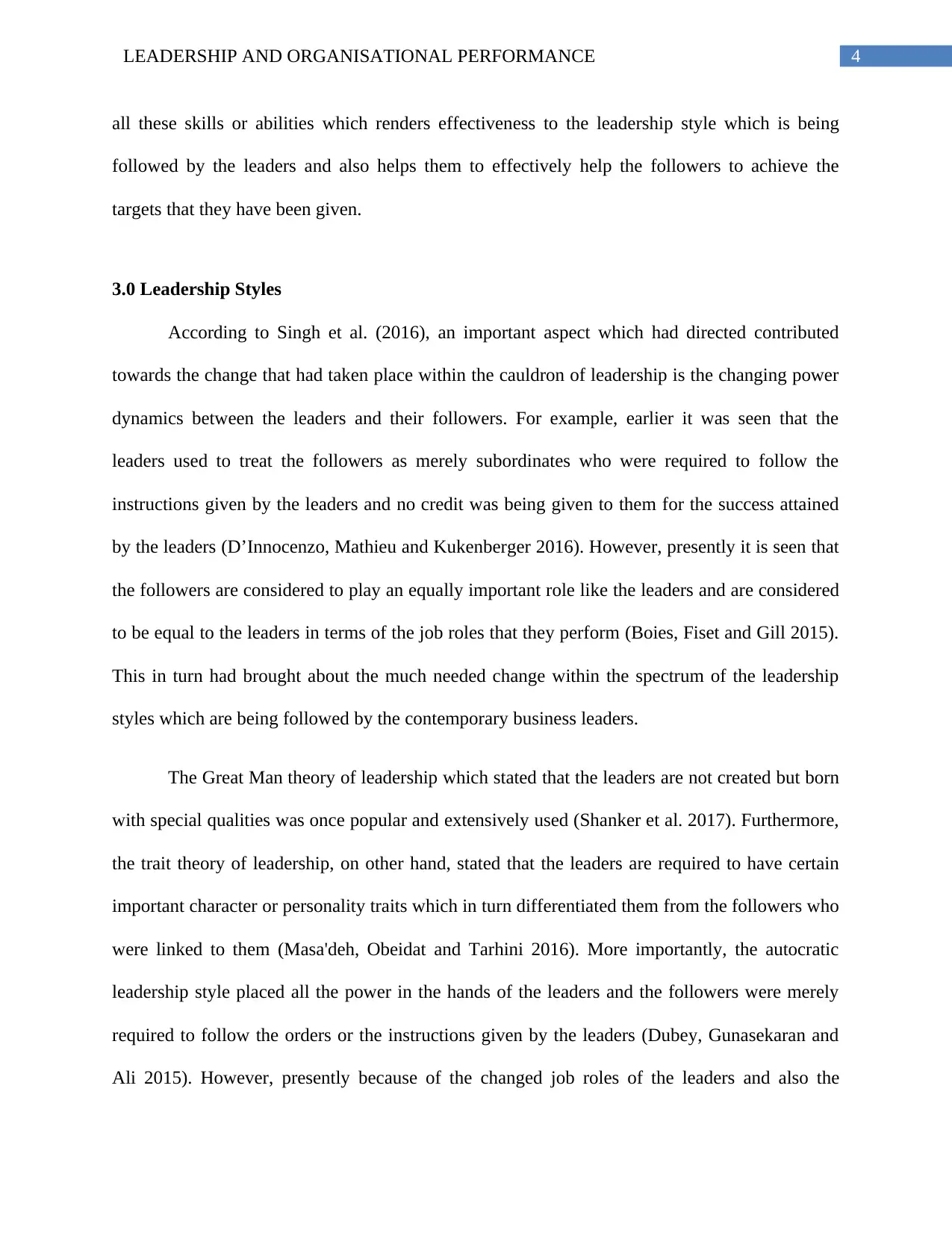
4LEADERSHIP AND ORGANISATIONAL PERFORMANCE
all these skills or abilities which renders effectiveness to the leadership style which is being
followed by the leaders and also helps them to effectively help the followers to achieve the
targets that they have been given.
3.0 Leadership Styles
According to Singh et al. (2016), an important aspect which had directed contributed
towards the change that had taken place within the cauldron of leadership is the changing power
dynamics between the leaders and their followers. For example, earlier it was seen that the
leaders used to treat the followers as merely subordinates who were required to follow the
instructions given by the leaders and no credit was being given to them for the success attained
by the leaders (D’Innocenzo, Mathieu and Kukenberger 2016). However, presently it is seen that
the followers are considered to play an equally important role like the leaders and are considered
to be equal to the leaders in terms of the job roles that they perform (Boies, Fiset and Gill 2015).
This in turn had brought about the much needed change within the spectrum of the leadership
styles which are being followed by the contemporary business leaders.
The Great Man theory of leadership which stated that the leaders are not created but born
with special qualities was once popular and extensively used (Shanker et al. 2017). Furthermore,
the trait theory of leadership, on other hand, stated that the leaders are required to have certain
important character or personality traits which in turn differentiated them from the followers who
were linked to them (Masa'deh, Obeidat and Tarhini 2016). More importantly, the autocratic
leadership style placed all the power in the hands of the leaders and the followers were merely
required to follow the orders or the instructions given by the leaders (Dubey, Gunasekaran and
Ali 2015). However, presently because of the changed job roles of the leaders and also the
all these skills or abilities which renders effectiveness to the leadership style which is being
followed by the leaders and also helps them to effectively help the followers to achieve the
targets that they have been given.
3.0 Leadership Styles
According to Singh et al. (2016), an important aspect which had directed contributed
towards the change that had taken place within the cauldron of leadership is the changing power
dynamics between the leaders and their followers. For example, earlier it was seen that the
leaders used to treat the followers as merely subordinates who were required to follow the
instructions given by the leaders and no credit was being given to them for the success attained
by the leaders (D’Innocenzo, Mathieu and Kukenberger 2016). However, presently it is seen that
the followers are considered to play an equally important role like the leaders and are considered
to be equal to the leaders in terms of the job roles that they perform (Boies, Fiset and Gill 2015).
This in turn had brought about the much needed change within the spectrum of the leadership
styles which are being followed by the contemporary business leaders.
The Great Man theory of leadership which stated that the leaders are not created but born
with special qualities was once popular and extensively used (Shanker et al. 2017). Furthermore,
the trait theory of leadership, on other hand, stated that the leaders are required to have certain
important character or personality traits which in turn differentiated them from the followers who
were linked to them (Masa'deh, Obeidat and Tarhini 2016). More importantly, the autocratic
leadership style placed all the power in the hands of the leaders and the followers were merely
required to follow the orders or the instructions given by the leaders (Dubey, Gunasekaran and
Ali 2015). However, presently because of the changed job roles of the leaders and also the
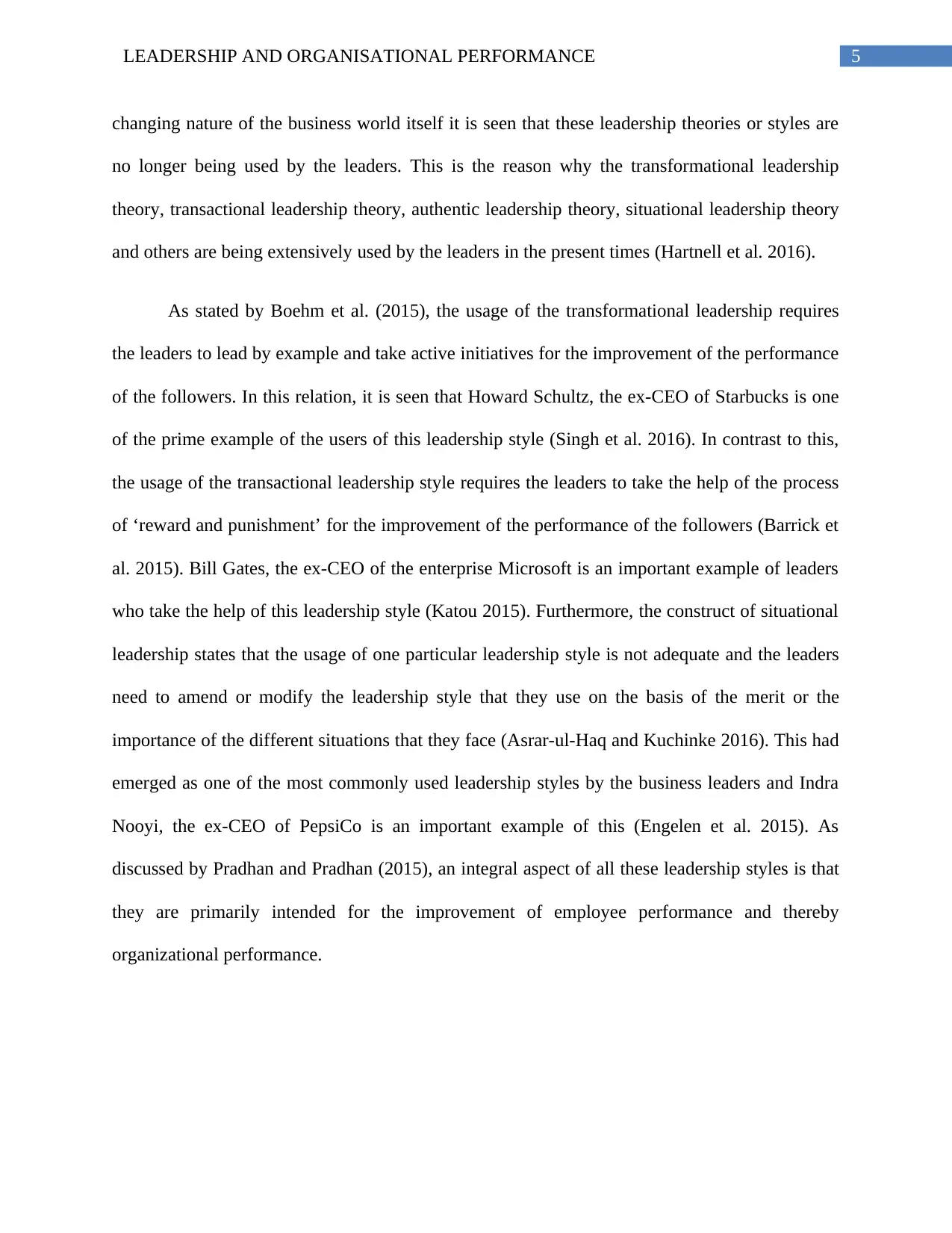
5LEADERSHIP AND ORGANISATIONAL PERFORMANCE
changing nature of the business world itself it is seen that these leadership theories or styles are
no longer being used by the leaders. This is the reason why the transformational leadership
theory, transactional leadership theory, authentic leadership theory, situational leadership theory
and others are being extensively used by the leaders in the present times (Hartnell et al. 2016).
As stated by Boehm et al. (2015), the usage of the transformational leadership requires
the leaders to lead by example and take active initiatives for the improvement of the performance
of the followers. In this relation, it is seen that Howard Schultz, the ex-CEO of Starbucks is one
of the prime example of the users of this leadership style (Singh et al. 2016). In contrast to this,
the usage of the transactional leadership style requires the leaders to take the help of the process
of ‘reward and punishment’ for the improvement of the performance of the followers (Barrick et
al. 2015). Bill Gates, the ex-CEO of the enterprise Microsoft is an important example of leaders
who take the help of this leadership style (Katou 2015). Furthermore, the construct of situational
leadership states that the usage of one particular leadership style is not adequate and the leaders
need to amend or modify the leadership style that they use on the basis of the merit or the
importance of the different situations that they face (Asrar-ul-Haq and Kuchinke 2016). This had
emerged as one of the most commonly used leadership styles by the business leaders and Indra
Nooyi, the ex-CEO of PepsiCo is an important example of this (Engelen et al. 2015). As
discussed by Pradhan and Pradhan (2015), an integral aspect of all these leadership styles is that
they are primarily intended for the improvement of employee performance and thereby
organizational performance.
changing nature of the business world itself it is seen that these leadership theories or styles are
no longer being used by the leaders. This is the reason why the transformational leadership
theory, transactional leadership theory, authentic leadership theory, situational leadership theory
and others are being extensively used by the leaders in the present times (Hartnell et al. 2016).
As stated by Boehm et al. (2015), the usage of the transformational leadership requires
the leaders to lead by example and take active initiatives for the improvement of the performance
of the followers. In this relation, it is seen that Howard Schultz, the ex-CEO of Starbucks is one
of the prime example of the users of this leadership style (Singh et al. 2016). In contrast to this,
the usage of the transactional leadership style requires the leaders to take the help of the process
of ‘reward and punishment’ for the improvement of the performance of the followers (Barrick et
al. 2015). Bill Gates, the ex-CEO of the enterprise Microsoft is an important example of leaders
who take the help of this leadership style (Katou 2015). Furthermore, the construct of situational
leadership states that the usage of one particular leadership style is not adequate and the leaders
need to amend or modify the leadership style that they use on the basis of the merit or the
importance of the different situations that they face (Asrar-ul-Haq and Kuchinke 2016). This had
emerged as one of the most commonly used leadership styles by the business leaders and Indra
Nooyi, the ex-CEO of PepsiCo is an important example of this (Engelen et al. 2015). As
discussed by Pradhan and Pradhan (2015), an integral aspect of all these leadership styles is that
they are primarily intended for the improvement of employee performance and thereby
organizational performance.
⊘ This is a preview!⊘
Do you want full access?
Subscribe today to unlock all pages.

Trusted by 1+ million students worldwide
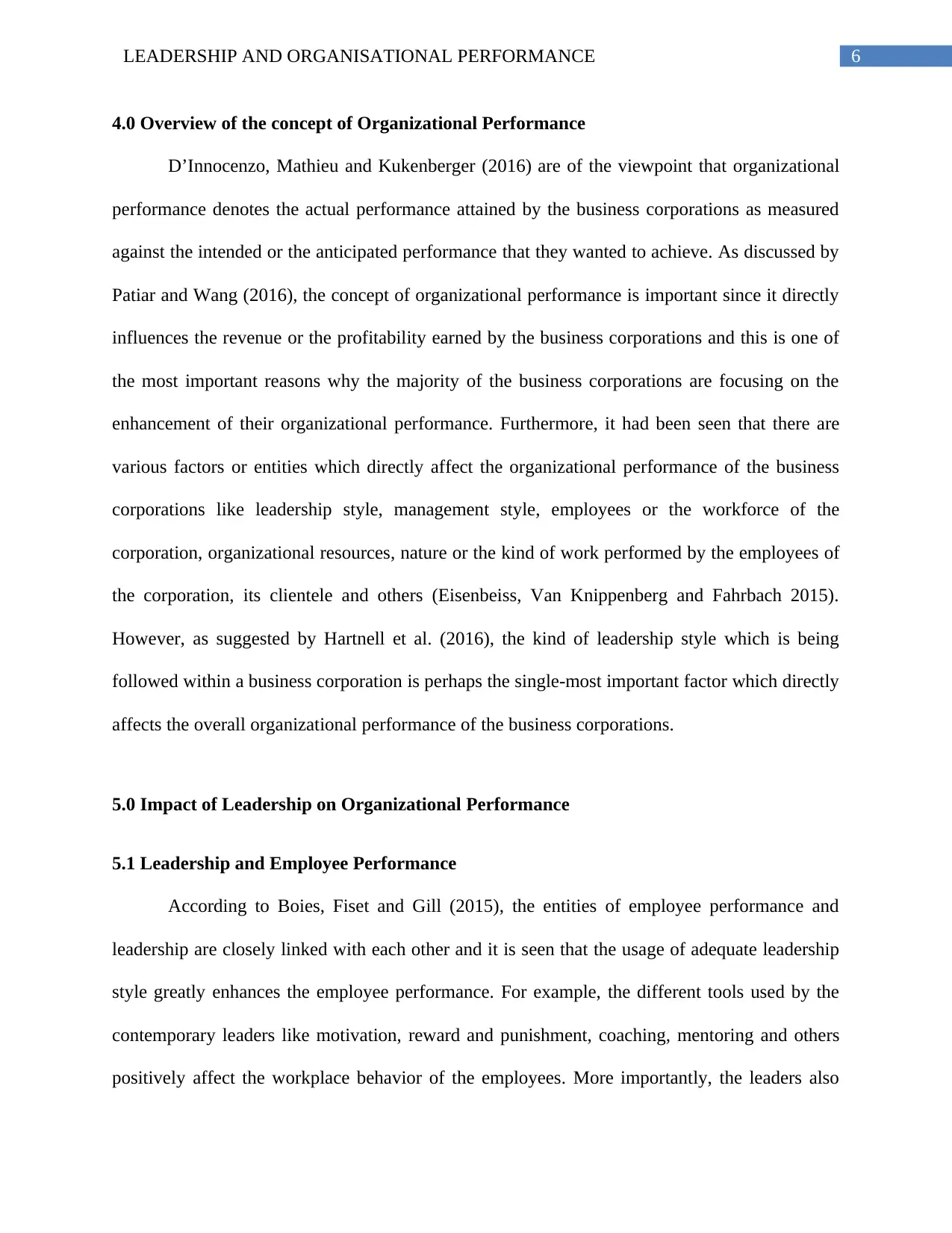
6LEADERSHIP AND ORGANISATIONAL PERFORMANCE
4.0 Overview of the concept of Organizational Performance
D’Innocenzo, Mathieu and Kukenberger (2016) are of the viewpoint that organizational
performance denotes the actual performance attained by the business corporations as measured
against the intended or the anticipated performance that they wanted to achieve. As discussed by
Patiar and Wang (2016), the concept of organizational performance is important since it directly
influences the revenue or the profitability earned by the business corporations and this is one of
the most important reasons why the majority of the business corporations are focusing on the
enhancement of their organizational performance. Furthermore, it had been seen that there are
various factors or entities which directly affect the organizational performance of the business
corporations like leadership style, management style, employees or the workforce of the
corporation, organizational resources, nature or the kind of work performed by the employees of
the corporation, its clientele and others (Eisenbeiss, Van Knippenberg and Fahrbach 2015).
However, as suggested by Hartnell et al. (2016), the kind of leadership style which is being
followed within a business corporation is perhaps the single-most important factor which directly
affects the overall organizational performance of the business corporations.
5.0 Impact of Leadership on Organizational Performance
5.1 Leadership and Employee Performance
According to Boies, Fiset and Gill (2015), the entities of employee performance and
leadership are closely linked with each other and it is seen that the usage of adequate leadership
style greatly enhances the employee performance. For example, the different tools used by the
contemporary leaders like motivation, reward and punishment, coaching, mentoring and others
positively affect the workplace behavior of the employees. More importantly, the leaders also
4.0 Overview of the concept of Organizational Performance
D’Innocenzo, Mathieu and Kukenberger (2016) are of the viewpoint that organizational
performance denotes the actual performance attained by the business corporations as measured
against the intended or the anticipated performance that they wanted to achieve. As discussed by
Patiar and Wang (2016), the concept of organizational performance is important since it directly
influences the revenue or the profitability earned by the business corporations and this is one of
the most important reasons why the majority of the business corporations are focusing on the
enhancement of their organizational performance. Furthermore, it had been seen that there are
various factors or entities which directly affect the organizational performance of the business
corporations like leadership style, management style, employees or the workforce of the
corporation, organizational resources, nature or the kind of work performed by the employees of
the corporation, its clientele and others (Eisenbeiss, Van Knippenberg and Fahrbach 2015).
However, as suggested by Hartnell et al. (2016), the kind of leadership style which is being
followed within a business corporation is perhaps the single-most important factor which directly
affects the overall organizational performance of the business corporations.
5.0 Impact of Leadership on Organizational Performance
5.1 Leadership and Employee Performance
According to Boies, Fiset and Gill (2015), the entities of employee performance and
leadership are closely linked with each other and it is seen that the usage of adequate leadership
style greatly enhances the employee performance. For example, the different tools used by the
contemporary leaders like motivation, reward and punishment, coaching, mentoring and others
positively affect the workplace behavior of the employees. More importantly, the leaders also
Paraphrase This Document
Need a fresh take? Get an instant paraphrase of this document with our AI Paraphraser
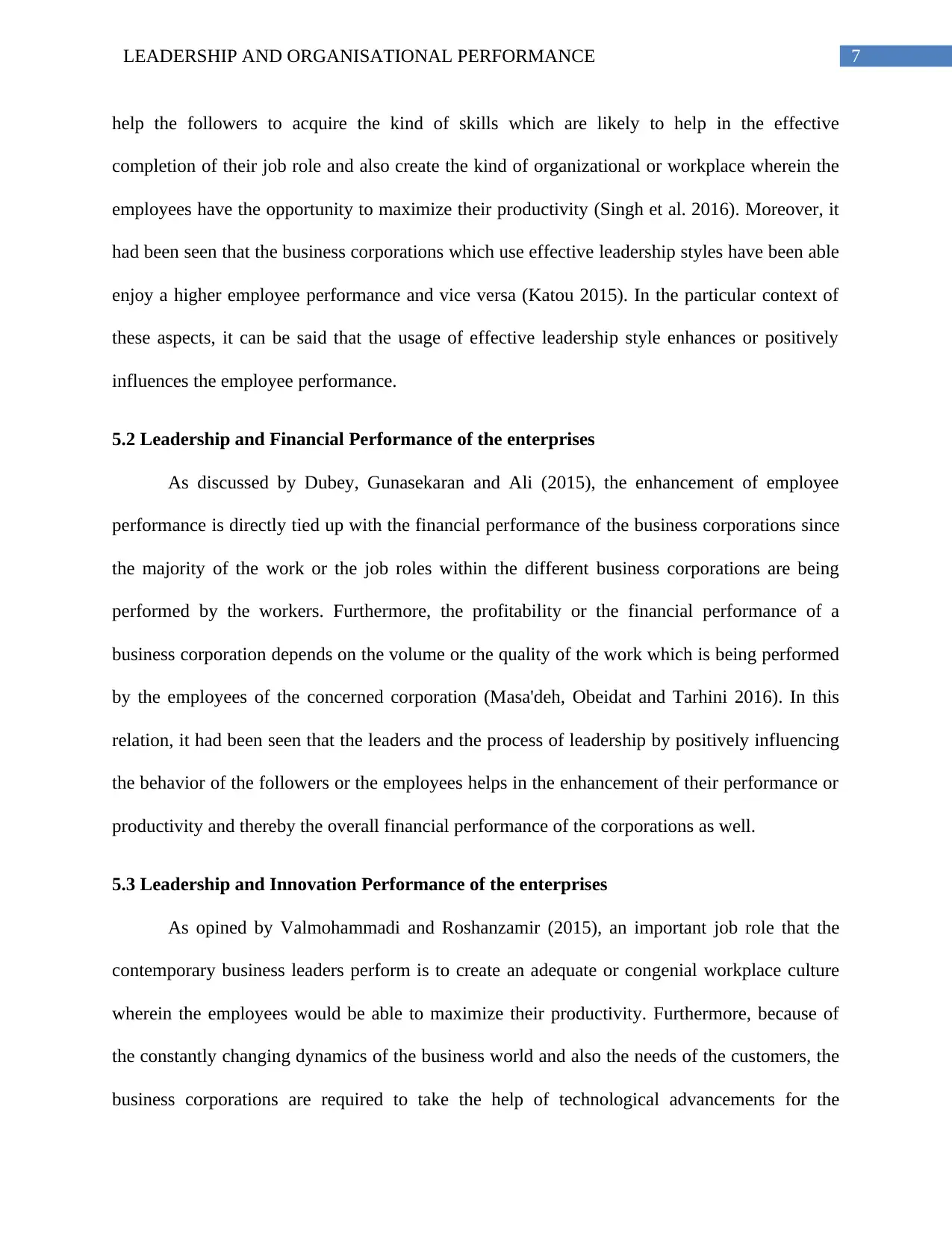
7LEADERSHIP AND ORGANISATIONAL PERFORMANCE
help the followers to acquire the kind of skills which are likely to help in the effective
completion of their job role and also create the kind of organizational or workplace wherein the
employees have the opportunity to maximize their productivity (Singh et al. 2016). Moreover, it
had been seen that the business corporations which use effective leadership styles have been able
enjoy a higher employee performance and vice versa (Katou 2015). In the particular context of
these aspects, it can be said that the usage of effective leadership style enhances or positively
influences the employee performance.
5.2 Leadership and Financial Performance of the enterprises
As discussed by Dubey, Gunasekaran and Ali (2015), the enhancement of employee
performance is directly tied up with the financial performance of the business corporations since
the majority of the work or the job roles within the different business corporations are being
performed by the workers. Furthermore, the profitability or the financial performance of a
business corporation depends on the volume or the quality of the work which is being performed
by the employees of the concerned corporation (Masa'deh, Obeidat and Tarhini 2016). In this
relation, it had been seen that the leaders and the process of leadership by positively influencing
the behavior of the followers or the employees helps in the enhancement of their performance or
productivity and thereby the overall financial performance of the corporations as well.
5.3 Leadership and Innovation Performance of the enterprises
As opined by Valmohammadi and Roshanzamir (2015), an important job role that the
contemporary business leaders perform is to create an adequate or congenial workplace culture
wherein the employees would be able to maximize their productivity. Furthermore, because of
the constantly changing dynamics of the business world and also the needs of the customers, the
business corporations are required to take the help of technological advancements for the
help the followers to acquire the kind of skills which are likely to help in the effective
completion of their job role and also create the kind of organizational or workplace wherein the
employees have the opportunity to maximize their productivity (Singh et al. 2016). Moreover, it
had been seen that the business corporations which use effective leadership styles have been able
enjoy a higher employee performance and vice versa (Katou 2015). In the particular context of
these aspects, it can be said that the usage of effective leadership style enhances or positively
influences the employee performance.
5.2 Leadership and Financial Performance of the enterprises
As discussed by Dubey, Gunasekaran and Ali (2015), the enhancement of employee
performance is directly tied up with the financial performance of the business corporations since
the majority of the work or the job roles within the different business corporations are being
performed by the workers. Furthermore, the profitability or the financial performance of a
business corporation depends on the volume or the quality of the work which is being performed
by the employees of the concerned corporation (Masa'deh, Obeidat and Tarhini 2016). In this
relation, it had been seen that the leaders and the process of leadership by positively influencing
the behavior of the followers or the employees helps in the enhancement of their performance or
productivity and thereby the overall financial performance of the corporations as well.
5.3 Leadership and Innovation Performance of the enterprises
As opined by Valmohammadi and Roshanzamir (2015), an important job role that the
contemporary business leaders perform is to create an adequate or congenial workplace culture
wherein the employees would be able to maximize their productivity. Furthermore, because of
the constantly changing dynamics of the business world and also the needs of the customers, the
business corporations are required to take the help of technological advancements for the

8LEADERSHIP AND ORGANISATIONAL PERFORMANCE
purpose of offering innovative products or services (Patiar and Wang 2016). Thus, the leaders
are required to encourage the employees to take the help of the processes of innovation and
creativity for the creation of a continuous learning environment and thereby enhance the
innovation performance of the corporations.
5.4 Leadership and Sustainability and Responsibility of the enterprises
Boehm et al. (2015) have noted that the leaders are required to focus on the long-term
growth of the corporations rather than short-term growth so as to help them to attain
sustainability and competitive advantage within the business market of their operation. However,
for the attainment of this goal the leaders are required to encourage the corporations to take
responsibility for their actions or show greatly accountability. More importantly, the leaders are
also required to play a pivotal role in the formulation of the corporate social responsibility (CSR)
practices used by the corporations for the fulfillment of their responsibility as business
corporations (Singh et al. 2016). Thus, it can be said that the leaders are required to take the help
of different measures for the purpose of encouraging the business corporations to take greater
responsibility for their business activities and also for the attainment of sustainability.
6.0 Conclusion
There is no dearth of literature on the relationship between leadership and organizational
performance however there are very few researches which have specifically focused on the
relationship of leadership to financial performance, innovation performance and other specific
kind of performances of the corporations. Thus, by effectively focusing on these aspects this
research will be a unique one and therefore the future researchers conducting researches would
have the opportunity to use this research as a basic framework for conducting their researches.
purpose of offering innovative products or services (Patiar and Wang 2016). Thus, the leaders
are required to encourage the employees to take the help of the processes of innovation and
creativity for the creation of a continuous learning environment and thereby enhance the
innovation performance of the corporations.
5.4 Leadership and Sustainability and Responsibility of the enterprises
Boehm et al. (2015) have noted that the leaders are required to focus on the long-term
growth of the corporations rather than short-term growth so as to help them to attain
sustainability and competitive advantage within the business market of their operation. However,
for the attainment of this goal the leaders are required to encourage the corporations to take
responsibility for their actions or show greatly accountability. More importantly, the leaders are
also required to play a pivotal role in the formulation of the corporate social responsibility (CSR)
practices used by the corporations for the fulfillment of their responsibility as business
corporations (Singh et al. 2016). Thus, it can be said that the leaders are required to take the help
of different measures for the purpose of encouraging the business corporations to take greater
responsibility for their business activities and also for the attainment of sustainability.
6.0 Conclusion
There is no dearth of literature on the relationship between leadership and organizational
performance however there are very few researches which have specifically focused on the
relationship of leadership to financial performance, innovation performance and other specific
kind of performances of the corporations. Thus, by effectively focusing on these aspects this
research will be a unique one and therefore the future researchers conducting researches would
have the opportunity to use this research as a basic framework for conducting their researches.
⊘ This is a preview!⊘
Do you want full access?
Subscribe today to unlock all pages.

Trusted by 1+ million students worldwide
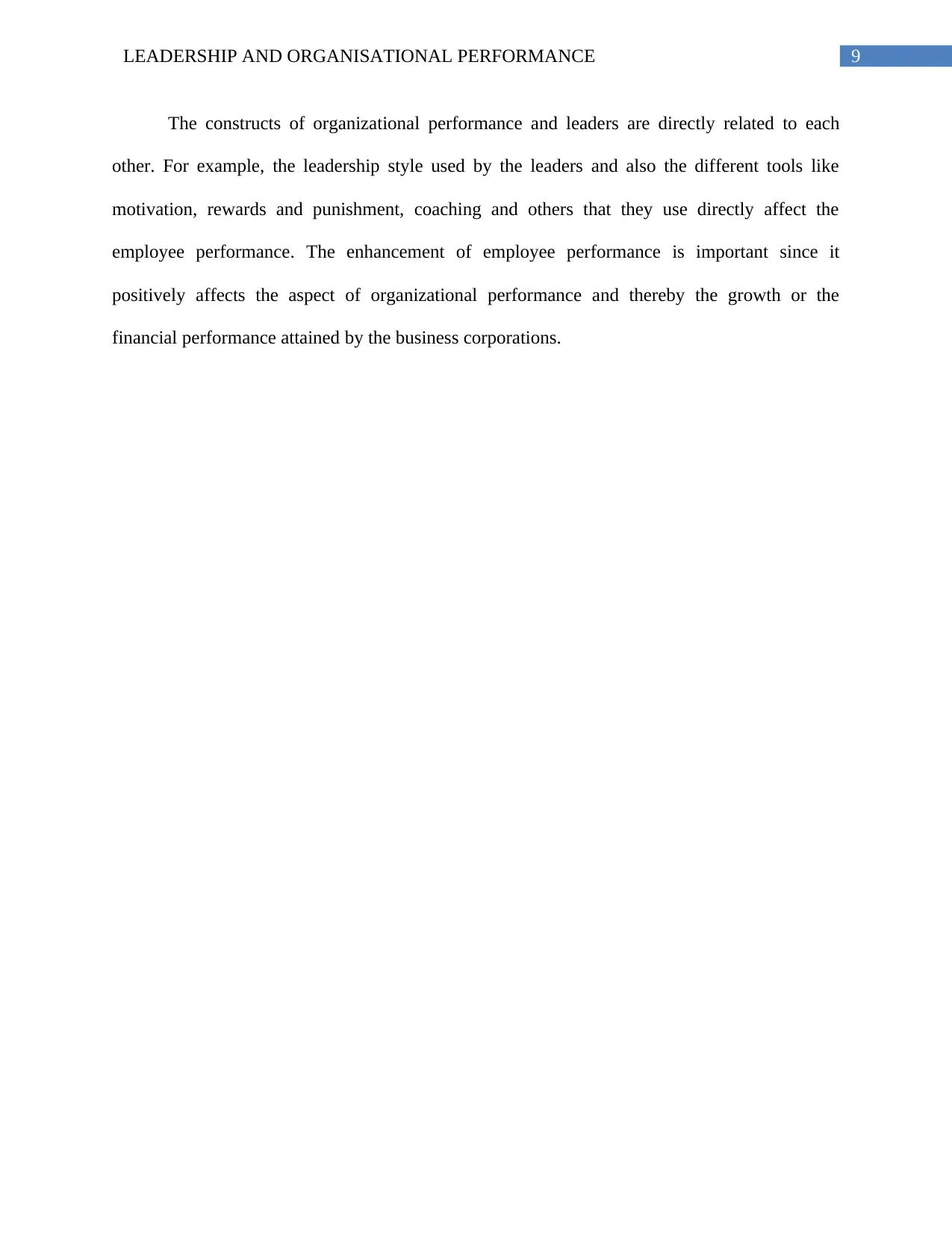
9LEADERSHIP AND ORGANISATIONAL PERFORMANCE
The constructs of organizational performance and leaders are directly related to each
other. For example, the leadership style used by the leaders and also the different tools like
motivation, rewards and punishment, coaching and others that they use directly affect the
employee performance. The enhancement of employee performance is important since it
positively affects the aspect of organizational performance and thereby the growth or the
financial performance attained by the business corporations.
The constructs of organizational performance and leaders are directly related to each
other. For example, the leadership style used by the leaders and also the different tools like
motivation, rewards and punishment, coaching and others that they use directly affect the
employee performance. The enhancement of employee performance is important since it
positively affects the aspect of organizational performance and thereby the growth or the
financial performance attained by the business corporations.
Paraphrase This Document
Need a fresh take? Get an instant paraphrase of this document with our AI Paraphraser

10LEADERSHIP AND ORGANISATIONAL PERFORMANCE
7.0 References
Asrar-ul-Haq, M. and Kuchinke, K.P., 2016. Impact of leadership styles on employees’ attitude
towards their leader and performance: Empirical evidence from Pakistani banks. Future Business
Journal, 2(1), pp.54-64.
Barrick, M.R., Thurgood, G.R., Smith, T.A. and Courtright, S.H., 2015. Collective
organizational engagement: Linking motivational antecedents, strategic implementation, and
firm performance. Academy of Management journal, 58(1), pp.111-135.
Boehm, S.A., Dwertmann, D.J., Bruch, H. and Shamir, B., 2015. The missing link? Investigating
organizational identity strength and transformational leadership climate as mechanisms that
connect CEO charisma with firm performance. The Leadership Quarterly, 26(2), pp.156-171.
Boies, K., Fiset, J. and Gill, H., 2015. Communication and trust are key: Unlocking the
relationship between leadership and team performance and creativity. The Leadership
Quarterly, 26(6), pp.1080-1094.
D’Innocenzo, L., Mathieu, J.E. and Kukenberger, M.R., 2016. A meta-analysis of different forms
of shared leadership–team performance relations. Journal of Management, 42(7), pp.1964-1991.
Dubey, R., Gunasekaran, A. and Ali, S.S., 2015. Exploring the relationship between leadership,
operational practices, institutional pressures and environmental performance: A framework for
green supply chain. International Journal of Production Economics, 160, pp.120-132.
7.0 References
Asrar-ul-Haq, M. and Kuchinke, K.P., 2016. Impact of leadership styles on employees’ attitude
towards their leader and performance: Empirical evidence from Pakistani banks. Future Business
Journal, 2(1), pp.54-64.
Barrick, M.R., Thurgood, G.R., Smith, T.A. and Courtright, S.H., 2015. Collective
organizational engagement: Linking motivational antecedents, strategic implementation, and
firm performance. Academy of Management journal, 58(1), pp.111-135.
Boehm, S.A., Dwertmann, D.J., Bruch, H. and Shamir, B., 2015. The missing link? Investigating
organizational identity strength and transformational leadership climate as mechanisms that
connect CEO charisma with firm performance. The Leadership Quarterly, 26(2), pp.156-171.
Boies, K., Fiset, J. and Gill, H., 2015. Communication and trust are key: Unlocking the
relationship between leadership and team performance and creativity. The Leadership
Quarterly, 26(6), pp.1080-1094.
D’Innocenzo, L., Mathieu, J.E. and Kukenberger, M.R., 2016. A meta-analysis of different forms
of shared leadership–team performance relations. Journal of Management, 42(7), pp.1964-1991.
Dubey, R., Gunasekaran, A. and Ali, S.S., 2015. Exploring the relationship between leadership,
operational practices, institutional pressures and environmental performance: A framework for
green supply chain. International Journal of Production Economics, 160, pp.120-132.
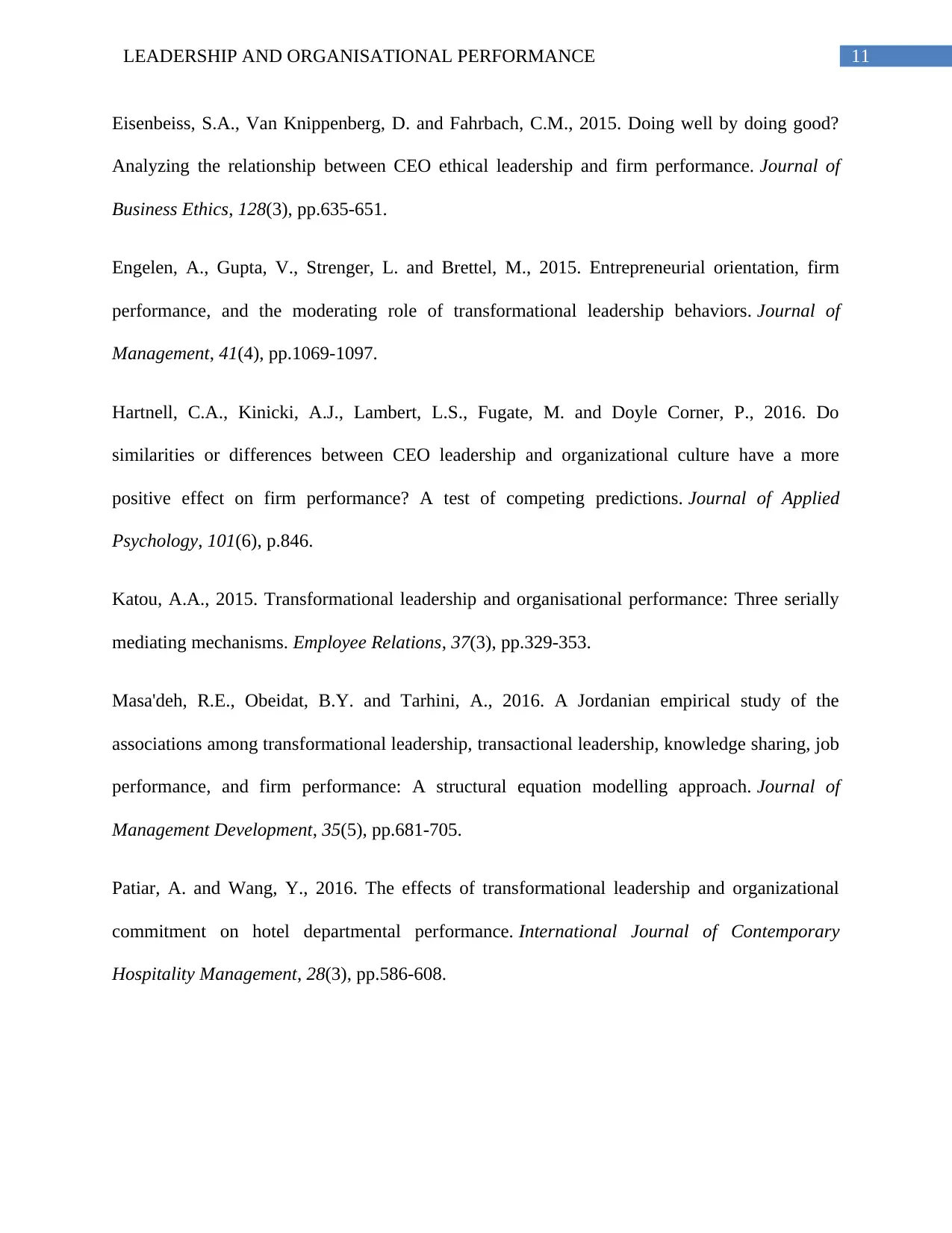
11LEADERSHIP AND ORGANISATIONAL PERFORMANCE
Eisenbeiss, S.A., Van Knippenberg, D. and Fahrbach, C.M., 2015. Doing well by doing good?
Analyzing the relationship between CEO ethical leadership and firm performance. Journal of
Business Ethics, 128(3), pp.635-651.
Engelen, A., Gupta, V., Strenger, L. and Brettel, M., 2015. Entrepreneurial orientation, firm
performance, and the moderating role of transformational leadership behaviors. Journal of
Management, 41(4), pp.1069-1097.
Hartnell, C.A., Kinicki, A.J., Lambert, L.S., Fugate, M. and Doyle Corner, P., 2016. Do
similarities or differences between CEO leadership and organizational culture have a more
positive effect on firm performance? A test of competing predictions. Journal of Applied
Psychology, 101(6), p.846.
Katou, A.A., 2015. Transformational leadership and organisational performance: Three serially
mediating mechanisms. Employee Relations, 37(3), pp.329-353.
Masa'deh, R.E., Obeidat, B.Y. and Tarhini, A., 2016. A Jordanian empirical study of the
associations among transformational leadership, transactional leadership, knowledge sharing, job
performance, and firm performance: A structural equation modelling approach. Journal of
Management Development, 35(5), pp.681-705.
Patiar, A. and Wang, Y., 2016. The effects of transformational leadership and organizational
commitment on hotel departmental performance. International Journal of Contemporary
Hospitality Management, 28(3), pp.586-608.
Eisenbeiss, S.A., Van Knippenberg, D. and Fahrbach, C.M., 2015. Doing well by doing good?
Analyzing the relationship between CEO ethical leadership and firm performance. Journal of
Business Ethics, 128(3), pp.635-651.
Engelen, A., Gupta, V., Strenger, L. and Brettel, M., 2015. Entrepreneurial orientation, firm
performance, and the moderating role of transformational leadership behaviors. Journal of
Management, 41(4), pp.1069-1097.
Hartnell, C.A., Kinicki, A.J., Lambert, L.S., Fugate, M. and Doyle Corner, P., 2016. Do
similarities or differences between CEO leadership and organizational culture have a more
positive effect on firm performance? A test of competing predictions. Journal of Applied
Psychology, 101(6), p.846.
Katou, A.A., 2015. Transformational leadership and organisational performance: Three serially
mediating mechanisms. Employee Relations, 37(3), pp.329-353.
Masa'deh, R.E., Obeidat, B.Y. and Tarhini, A., 2016. A Jordanian empirical study of the
associations among transformational leadership, transactional leadership, knowledge sharing, job
performance, and firm performance: A structural equation modelling approach. Journal of
Management Development, 35(5), pp.681-705.
Patiar, A. and Wang, Y., 2016. The effects of transformational leadership and organizational
commitment on hotel departmental performance. International Journal of Contemporary
Hospitality Management, 28(3), pp.586-608.
⊘ This is a preview!⊘
Do you want full access?
Subscribe today to unlock all pages.

Trusted by 1+ million students worldwide
1 out of 13
Related Documents
Your All-in-One AI-Powered Toolkit for Academic Success.
+13062052269
info@desklib.com
Available 24*7 on WhatsApp / Email
![[object Object]](/_next/static/media/star-bottom.7253800d.svg)
Unlock your academic potential
Copyright © 2020–2025 A2Z Services. All Rights Reserved. Developed and managed by ZUCOL.




